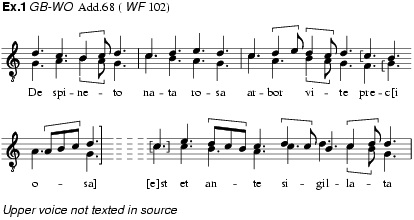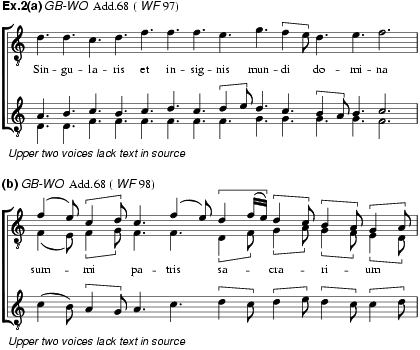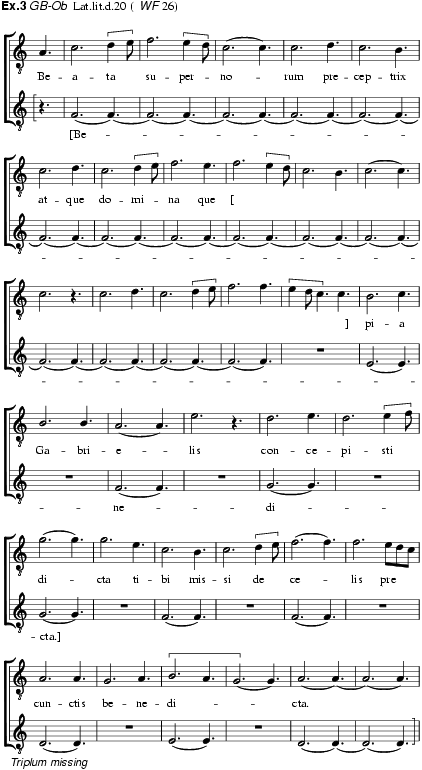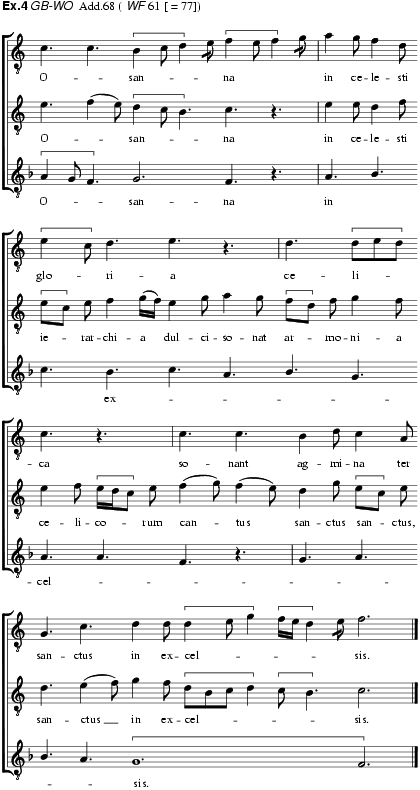
The so-called Worcester repertory, comprising more than 100 anonymous polyphonic compositions datable from between the early 13th century and the second quarter of the 14th.
The repertory is contained in 59 manuscript leaves, 40 of which are preserved in GB-WO Add.68. While there is no certainty regarding the original provenance of any of the leaves, most of which are in more or less fragmentary condition, the available indications point to Worcester as a major centre of polyphonic composition, hence the frequently used term ‘Worcester Fragments’. Concordances show that the Worcester music was influential elsewhere in England. On the other hand, the ‘Worcester Fragments’ contain little more than a third of all the completely preserved English polyphony of the 13th century. Some of the compositions in other sources may also have originated in Worcester. (For more detailed information on sources see Sources, MS, §VI.)
The repertory can be seen as falling chronologically into five main groups of pieces. Of these the second is by far the largest. Each can further be divided into its several categories of composition. The discussion below follows such a scheme of classification. (‘WF’ refers to the edition in MSD, ii, 1957; numbers in square brackets refer to English Music of the 13th and Early 14th Centuries, ed. E.H. Sanders, 1979.)
The earliest compositions (WF 97 [= App.14], 98 [= 64], 99 [= 21], 100, 101 [= App.1], 102–6) are mostly two-voice settings of sequences, written in a largely note-against-note technique that is also known from other insular sources (e.g. GB-Lbl Sloane 1580, Ob 343, F-Pn fr.25408, GB-Lbl Arundel 248) as well as continental ones. A notable feature of many of these English pieces is the relative frequency of the contrapuntal interval of the 3rd. Since the accompanying ‘upper’ voice tends to occupy the same register as the tenor, the voices cross rather frequently (ex.1). One of these early pieces (WF 99) is a conductus with cauda, while WF 97 and 98 are cantus firmus settings (of an offertory prose and of a hymn, respectively; exx.2a–b). All three compositions are for three voices, as is more than four-fifths of the entire Worcester repertory.


Our knowledge of Worcester polyphony in the first half of the 13th century remains sadly incomplete, since only one other composition from that period survives. It is a three-voice measured organum setting of the Alleluia Nativitas (for the Nativity of the Virgin) dating perhaps from the 1230s (WF 81). This composition, clearly inspired by Perotinus's famous three-voice organum on the same chant – it even quotes the motet form of the entire clausula Ex semine from his organum – favours discant style for the verse, but contains remarkably expansive organal sections in the setting of the respond. The evidence would seem to indicate that the composition of organum in the Perotinian manner was uncommon in England, but the state of preservation of English music of that period leaves the matter in doubt. In fact, remnants of organal style still appear in a few compositions from the end of the 13th century, such as a setting of the gradual Benedicta: Virgo dei genitrix (c1290, ex.3).

About three-fifths of the Worcester music may be dated from about 1270. This, except for the excessively fragmentary WF 4, 8, 24 and 38–40, can be divided into four categories:
(i) Rondelli (WF 5 [= 31], 25, 94 [= 41], rota (WF 21 [= 35]), and conductus, often with sectional voice-exchange or rondellus passages (WF 68, 69 [= 34], 92 [= App.11], 93 [= 36], 107).
(ii) Motets on a pes, with or without voice-exchange (WF 6 [= 54], 7, 10 [= 58], 11 [= 50], 12 [= 51], 13, 15 [= 52], 16 [= 53], 17, 18 [= 66], 20, 22, 23, 36, 65, 71 [= 47], 73 [= 48], 74, 75, 76 [= 49]). Apart from the pieces in Group I, nos.74 and 75 are the only extant two-part compositions.
(iii) Motets on a cantus firmus (WF 37, 70 [= 84], 72 [= 77], 95 [= 83]).
(iv) Troped chant settings, i.e. settings of a cantus firmus, itself sometimes extended by a trope, in which the original text is elaborated, intermittently or throughout, by poetic tropes in the newly composed upper voices (WF 1, 2 [= App.21], 3, 9 [= 67], 14, 34, 35, 42 [= 68], 63); Sanctus settings (WF 58–60, 61 [= 77], 62); and alleluias (WF 19 [= App.18a], 45, 46 [= App.20], 49, 50, 51, 52 [= App.17], 54, 55 [= App.19], 56 [= App.18b], 57). Most of those are compositions for Lady Masses (ex.4).

The stylistic distinctions between conductus and motet were not so rigid in 13th-century England as knowledge of the French repertory might lead one to expect. The role played by the techniques of Voice-exchange (in conductus as well as many pes motets) and Rondellus shows that the English predilection for extensive homogeneity in a composition accounts for a much greater stylistic homogeneity in the repertory as a whole than is the case in the French polyphony of the time. Even the few cantus-firmus motets (about a sixteenth of Group II) have cantus firmi that are melodically similar to pedes.
Homogeneity also characterizes the texts of the entire Worcester repertory. A large percentage of the poetry is Marian, and all the compositions set Latin texts. In England there was no parallel for the process by which the French ars musica early in the 14th century came to cultivate the polyphonic chanson, a primarily courtly species, and the Latin or French motet, a kind of university music with both ecclesiastical and courtly outlets. Not only were the composition and performance of polyphony in the hands of qualified members of the clergy, but nearly all their compositions are appropriate for divine service or special devotions, though some of the pieces may also have been produced in the hall on suitable occasions.
In the surviving English repertory of the second half of the 13th century most of the rondelli, most of the conductus with voice-exchange or rondellus sections and most of the pes motets are in F major or in a mixture of Lydian and F major (often the flat serves as clef). In almost every case the combined effect of the voices is the constant reinforcement of the tonic by means of elaborations of a tonic ostinato, with the supertonic, because of its cadential function, holding a place of structural importance second only to that of the tonic.
What gives much of the Worcester polyphony its characteristically English sound is the frequency of the major mode (mostly F major, because the 13th-century tonal system generally caused major to be expressed as a variant of Lydian); the stress on the chords of tonic and supertonic, and the emphasis on triads and, secondarily, 6-3 chords, with the latter occurring most prominently as penultimate chords at cadence points; frequency of foursquare phrase design; and an almost exclusive predilection for rhythms with trochaic ingredients, such as that in ex.5, and the rhythm known on the Continent as the 1st mode. The phrase endings emphasize certain degrees of the scale and relate them to one another and to the tonic, nearly always outlining a composition with well-planned tonal unity.

The English preference for fashioning tonally unified compositions is also evident in many of the chant settings, of which the most brilliant specimens are the alleluias, most of them presumed to have been composed by W. de Wycombe. In many cases the cantus firmi were changed so as to yield tonally unified tenors; at times the alteration amounts to no more than one or two notes, while in other cases the changes are more extensive. Troping texts in the upper voices are usually arranged in the manner of the old troped organa; that is, they include the liturgical words of the cantus firmus, which are placed so as to permit their simultaneous declamation by all three voices. To apply motet terminology to such settings would be inappropriate, since the rigid disposition of preconceived rhythmic patterns for structural purposes is untypical of this repertory. Instead of reinforcing polyphonic stratification, polytextuality produces a diversity that is carefully integrated to maintain the effect of organic homogeneity.
Stylistic and palaeographical considerations allow the tentative chronological division of the remaining Worcester repertory (30%) into three chronological groups.
These pieces date from about 1280–90, and fall into three categories:
(i) Rondellus (WF 31 [= 42]), conductus (WF 87, 89 [= App.12], 91 [= 43]), and a free Gloria setting (WF 88 [= 44]).
(ii) Pes motets (WF 41 [= 55], 30, 32).
(iii) Troped chant settings (WF 26, 27 [= 71], 28 [= 72], 29, 33).
These date from about 1295–1315, and are of five kinds:
(i) Cantilena (WF 109 [= App.13]).
(ii) Variation motets (WF 53 [= 60], 67 [= 61]).
(iii) Chant setting (WF 108 [= 66] – cantus firmus unidentified).
(iv) Troped chant settings (WF 43, 64 [= 74], 96).
(v) Motets on a cantus firmus (WF 44, 47, 78, 79 [= App.25], 80).
(vi) Inconclusive (WF 48).
These date from about 1330, and fall into three categories:
(i) Cantilena (WF 82).
(ii) Chant settings (WF 84–6).
(iii) Inconclusive (WF 83).
Shortly after 1300 rondelli became increasingly rare, and the three main types of English 14th-century polyphony (cantilenas; chant settings without textual tropes in the upper parts; and motets, especially cantus-firmus motets) can be seen to emerge. There is also an increase in the percentage of four-part writing, this having already appeared among the compositions of Group II (WF 10, 18, 70, 95). Evidently, English composers with their characteristic love of rich chordal sonority welcomed the increased opportunity for four-part counterpoint afforded by a two-voice framework that had expanded from an octave to a 12th, since of the 13 compositions in Group IV six (WF 53, 67, 78–80 and 64) are for four voices. Such a relatively high percentage of four-part writing does not, however, seem to remain typical of English polyphony in the later 14th century.
Two of the pieces of Group I (WF 100 and 81) and a great many compositions of Group II exhibit the notational system usually referred to as English mensural notation or as paired-English-breve notation. Its symbols were the ligatures of square notation and, for syllabic music, two single note shapes with specific mensural significance, i.e. the virga and the diamond (or rhomb), which was an ingredient of the climacus in the chant notation of the time. The diamond, often used in pairs in English mensural polyphony, represented the breve, in contrast to the continental notational systems of Johannes de Garlandia and his successors, in which it designated the semibreve.
The historical priority of the English notation of music cum littera may perhaps be deduced from the circumstance that in the earliest (pre-modal) mensural notation of the Notre Dame period, when the semibreve was still ultra mensuram (not precisely definable as a fraction of a breve), all but the last of the notes of the coniunctura (derived from the Gregorian climacus) signified breves. Since English polyphony before the last quarter of the 13th century evidently recognized only rhythms with trochaic ingredients (Franco’s 1st mode), its syllabic notation corresponds to this stylistic situation with ingenious economy. The virga represents the three-beat long, while the paired diamonds were conceived as breves, of which the first was twice as long as the second. To an extent this system is related to Franconian notation, except that the valuation of the paired breves is the reverse of his (ex.6a–b); some later compositions express the paired-diamond rhythm as in ex.6c)

There is evidence that these rhythms and a similar, if not identical, method of their notational representation were the only ones available in Paris before the rise of the modal system in clausula and motet. The rhythmic patterns of the 2nd and 3rd modes, however, remained quite rare in the Worcester polyphony (as elsewhere in 13th-century Europe other than France); even those late 13th-century compositions in which the breves are written as puncta in the continental manner often pair them in the traditional English fashion (long–short, in contrast to French precepts). In fact, in subsequent decades the English preference for trochaic rhythms often came to affect paired semibreves as well, again in contrast to continental practice (e.g. WF 67 and a good many compositions appearing in sources from the first half of the 14th century; see also ex.3).
A. Hughes, ed.: Worcester Medieval Harmony of the Thirteenth and Fourteenth Centuries (Burnham, Bucks, 1928/R)
L.A. Dittmer: ‘An English Discantuum Volumen’, MD, viii (1954), 19–58
L.A. Dittmer: ‘The Dating and the Notation of the Worcester Fragments’, MD, xi (1957), 5–11
L.A. Dittmer: The Worcester Fragments: a Catalogue Raisonné and Transcription, MSD, ii (1957)
E. Apfel: Studien zur Satztechnik der mittelalterlichen englischen Musik (Heidelberg, 1959)
L. Dittmer: Worcester Add. 68, Westminster Abbey 33327, Madrid, Bibl. Nac. 192, Publications of Mediaeval Musical Manuscripts, v (Brooklyn, NY, 1959)
L. Dittmer, ed.: Oxford, Latin Liturgical D20, London, Add. MS 25031, Chicago, MS 654 app., Publications of Mediaeval Musical Manuscripts, vi (Brooklyn, NY, 1960)
E. Apfel: ‘Über einige Zusammenhänge zwischen Text und Musik im Mittelalter, besonders in England’, AcM, xxxiii (1961), 47–54
E.H. Sanders: ‘Duple Rhythm and Alternate Third Mode in the 13th Century’, JAMS, xv (1962), 249–91
E.H. Sanders: ‘Tonal Aspects of 13th-Century English Polyphony’, AcM, xxxvii (1965), 19–34
D. Stevens: ‘The Worcester Fragments’, MT, cxvi (1975), 784–5
E.H. Sanders, ed.: English Music of the Thirteenth and Early Fourteenth Centuries, PMFC, xiv (1979)
F.Ll. Harrison and R. Wibberley, eds.: Manuscripts of Fourteenth Century English Polyphony: a Selection of Facsimiles, EECM, xxvi (1981)
P.M. Lefferts and M. Bent: ‘New Sources of English Thirteenth- and Fourteenth-Century Polyphony’, EMH, ii (1982), 273–362
P.M. Lefferts: The Motet in England in the Fourteenth Century (Ann Arbor, 1986)
F. Büttner: Klang und Konstruktion in der englischen Mehrstimmigkeit des 13. Jahrhunderts: ein Beitrag zur Erforschung der Stimmtauschkompositionem in den Worcester-Fragmenten (Tutzing, 1990)
N. Losseff: The Best Concords: Polyphonic Music in Thirteenth-Century Britain (New York, 1994)
ERNEST H. SANDERS